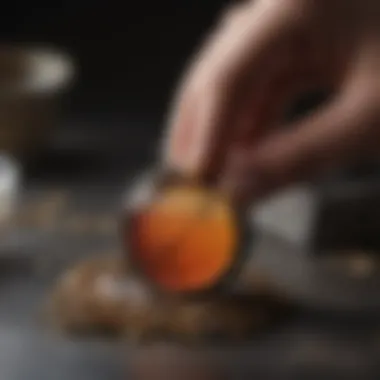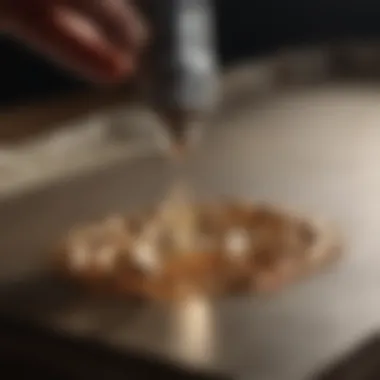Mastering the Art of Jewellery Glue: A Comprehensive Guide


The In-Depth Guide to Glue for Jewellery Making
Delving into the intricate world of jewellery making, it is crucial to understand the diverse range of glues employed in this refined craft. From delicate metalwork to intricate gem settings, the choice of adhesive plays a pivotal role in ensuring the longevity and structural integrity of each piece. This comprehensive guide aims to enlighten enthusiasts on the nuances of epoxy resins and cyanoacrylate adhesives, imparting invaluable knowledge on how to impeccably bond an array of materials in their artistic endeavors.
Understanding Epoxy Resins and Cyanoacrylate Adhesives
Resilient and versatile, epoxy resins stand as stalwart companions in jewellery making, offering superior bonding strength and durability. On the other hand, cyanoacrylate adhesives, commonly known as super glue, provide quick adhesion and are ideal for securing small components with precision. It is essential to comprehend the distinct characteristics and best practices associated with each type of glue to optimize their application in various crafting projects.
Mastering Bonding Techniques and Material Compatibility
Navigating the realm of jewellery making demands a keen eye for detail and finesse in handling different materials. Whether bonding metal to gemstone or affixing embellishments onto intricate designs, mastering the art of material compatibility and accurate application techniques is paramount. This section offers practical insights and expert tips to empower artisans in creating cohesive and durable jewellery pieces through seamless bonding methods.
Precision in Application and Creative Solutions
Jewellery making is a blend of artistry and precision, where attention to detail serves as the cornerstone of aesthetic excellence. By delving into the precise application of glues and exploring innovative solutions for common bonding challenges, artisans can elevate their craftsmanship to new heights. Unleashing creativity through thoughtful preservation and display techniques enables the manifestation of exquisite jewellery pieces that captivate the senses and stand the test of time.
The Intersection of Science and Artistry in Glue Selection
Behind every stunning jewellery creation lies a meticulous selection process of the most suitable glue for the task at hand. With a deep dive into the science of adhesive bonding and the artistic vision driving each design, this section explores the profound impact of glue selection on the structural integrity and visual allure of jewellery pieces. By marrying scientific principles with artistic ingenuity, artisans can unravel new dimensions of creativity and finesse in their craft.
Conclusion: Crafting Excellence Through Adhesive Mastery
In the realm of jewellery making, the choice of glue transcends mere practicality to become an indispensable tool for crafting excellence. By embracing the nuances of epoxy resins and cyanoacrylate adhesives, artisans can unlock a world of possibilities in creating intricate, enduring, and visually captivating jewellery pieces. This ultimate guide serves as a beacon of knowledge and inspiration, guiding enthusiasts towards mastering the art of adhesive application and sculpting timeless treasures that resonate with beauty and craftsmanship.
Introduction
Glue serves as the silent hero in the realm of jewellery making, where precision and durability are paramount. This article delves into the intricate world of glue for jewellery making, shedding light on the crucial role it plays in bonding various materials with finesse and strength.


Understanding the Importance of Glue in Jewellery Making
Choosing the right glue is a pivotal decision for jewellery artisans. Factors that make glue selection crucial encompass aspects like adhesive strength, material compatibility, and drying time. Opting for high-quality glue elevates the craftsmanship standards, ensuring lasting and resilient bonds. The adhesive compounds are the unsung heroes behind the shimmering jewels, as they dictate the longevity and robustness of the final piece. High-quality glue doesn't merely stick components together; it enhances the durability of the jewellery. Impact of high-quality glue on jewellery durability, lies in its ability to withstand external factors. This resilience prolongs the lifespan of the jewellery pieces, making them heirlooms that transcend time.
Overview of Different Types of Glue Used in Jewellery Making
Epoxy Resins
Epoxy resins boast exceptional bond strength and are favored for their versatility in jewellery crafting. Their ability to adhere to various materials with precision makes them a cornerstone of successful jewellery making. However, their longer curing time necessitates patience in the crafting process.
Cyanoacrylate Adhesives
Known for their fast-drying and strong bonding properties, cyanoacrylate adhesives are ideal for quick projects requiring instant adhesion. Their efficient application and reliable strength make them a popular choice among jewellery makers.
Factors to Consider When Choosing Glue for Jewellery Making
Material Compatibility
The compatibility of glue with different materials determines the efficiency of jewellery assembly. Selecting a glue that adheres well to metal, gemstones, wood, and fabric guarantees seamless integration of diverse elements in jewellery pieces. Understanding the chemical reactions between the glue and materials is vital to prevent undesirable interactions.
Drying Time
The drying time of glue influences the pace of jewellery production. Quick-drying adhesives expedite the crafting process, while slower curing variants offer flexibility for adjustments before setting. Balancing the need for speed and precision is crucial when selecting the appropriate glue for jewellery making.
Application Techniques
When delving into the intricate world of jewellery making, the application techniques play a critical role in achieving impeccable results. The way different materials are bonded together can significantly impact the final product's quality and durability. Employing the appropriate technique ensures a secure and long-lasting bond, essential for creating stunning jewellery pieces that stand the test of time.
Best Practices for Gluing Various Materials


Metal to Metal
In the realm of jewellery making, the bond between metals is paramount. Metal-to-metal adhesion is not only a common practice but also a crucial technique for crafting sturdy and resilient jewellery items. This method offers exceptional strength and reliability, making it a preferred choice for artisans aiming to create high-quality pieces. While metal-to-metal bonding provides robust connections, it may have limitations in terms of flexibility.
Metal to Gemstone
Another essential bond in jewellery making is the fusion between metal components and gemstones. This technique requires precision and care to preserve the integrity of the delicate gemstones. Metal-to-gemstone adhesion enables designers to incorporate precious stones into their creations seamlessly. However, this type of bond may pose challenges in terms of compatibility between the materials' properties.
Gemstone to Gemstone
When joining gemstones together, the technique of gemstone-to-gemstone bonding comes into play. This method allows for the creation of intricate designs where gemstones complement each other harmoniously. By carefully aligning and affixing gemstones, artisans can produce visually appealing and cohesive jewellery pieces. Nevertheless, connecting gemstones directly may require specialized adhesives to ensure a secure attachment.
Wood to Metal
The fusion of wood and metal elements in jewellery design opens up a realm of creativity and contrast. Wood-to-metal bonding introduces natural textures and tones, adding depth and character to the finished pieces. This blending of materials creates a unique aesthetic appeal, but it necessitates careful selection of adhesives that can effectively bond disparate surfaces like wood and metal.
Fabric to Metal
Incorporating fabric into jewellery designs offers a soft and elegant touch to adornments. The union of fabric to metal requires attention to detail to prevent fabric fraying or discoloration from adhesives. Bonding fabric to metal demands adhesives that provide a secure attachment without compromising the fabric's texture or appearance. This technique enables artisans to infuse textiles seamlessly into their creations, enhancing the overall design aesthetic.
Tips for Precision and Clean Application
Using Applicator Tips
Precision is key when applying glue in jewellery making, particularly when working with intricate components. Utilizing applicator tips allows for accurate and controlled dispensing of adhesives, facilitating clean and precise bonding. These specialized tips enable artisans to target specific areas without excess spillage or mess, enhancing the overall craftsmanship of the jewellery pieces.
Cleaning Excess Glue
After bonding materials, removing any excess glue is essential to maintain a polished and professional finish. Cleaning excess glue ensures that the final product appears seamless and refined, without visible traces of adhesive residue. This practice not only enhances the aesthetic appeal of the jewellery but also contributes to the longevity of the bond by eliminating potential weak spots caused by excess adhesive.


Avoiding Air Bubbles
To achieve a flawless bond in jewellery making, avoiding air bubbles during the adhesion process is imperative. Air bubbles can compromise the integrity of the bond, leading to potential structural weaknesses in the jewellery piece. By employing techniques that minimize air entrapment, such as applying consistent pressure during bonding and using appropriate adhesive viscosities, artisans can create smooth and durable connections between materials.
Maintenance and Care
In the realm of jewellery making, maintaining and caring for your creations is as critical as the crafting process itself. This section delves into the pivotal role of maintenance and care in preserving the beauty and longevity of bonded jewellery pieces. Ensuring proper upkeep not only sustains the aesthetic appeal but also guarantees the durability of the bonded materials. From protecting against environmental factors to implementing effective storage practices, meticulous attention to maintenance and care enhances the overall quality of jewellery creations.
Ensuring Longevity of Bonded Jewellery Pieces
Protecting from Moisture and Heat
Shielding bonded jewellery pieces from moisture and heat is paramount in safeguarding against degradation and potential damage. Moisture can corrode delicate materials and compromise adhesive integrity, while heat exposure can lead to warping or weakening of the bond. By protecting items from these elements, artisans can uphold the structural integrity of their pieces and retain their original charm. Implementing moisture and heat-resistant strategies ensures the longevity of bonded jewellery pieces, preserving their pristine condition over time.
Storage Tips for Preserving Glue Integrity
Effective storage practices play a vital role in maintaining the adhesive integrity of bonded jewellery pieces. Properly storing items in a cool, dry environment minimizes the risk of adhesive degradation and ensures optimal performance. By avoiding exposure to excessive humidity or temperature fluctuations, craftsmen can preserve the adhesive strength of their creations. Additionally, storing glue bottles upright and tightly sealed prevents drying out and contamination, prolonging the shelf life of adhesives. Incorporating these storage tips not only safeguards the quality of bonded jewellery pieces but also maximizes the usability of adhesives, facilitating efficient and successful crafting endeavors.
Conclusion
Jewellery making is a delicate art that relies heavily on the choice and application of the right glue. The conclusion of this article reinforces the pivotal role of proper gluing techniques in achieving durable and visually appealing jewellery pieces. Understanding the significance of surface preparation, glue selection, and follow-up inspections is crucial for ensuring the longevity and integrity of the final product. Failure to adhere to these key considerations can result in subpar craftsmanship, affecting both the aesthetic and structural quality of the jewellery.
Key Takeaways for Successful Gluing in Jewellery Making
Importance of Proper Surface Preparation
Proper surface preparation is a foundational aspect of successful jewellery making. It involves meticulously cleaning and priming the surfaces to be bonded, ensuring maximum adhesion strength. By promoting better surface contact and eliminating contaminants, proper preparation enhances the bond's durability and longevity. Jewellery artisans benefit from the predictability and consistency that come with thorough surface preparation, setting the stage for flawless craftsmanship and meticulous detailing. While time-consuming, this step is imperative for achieving professional results and upholding the standard of excellence in jewellery making practices.
Choosing the Right Glue for the Job
Selecting the appropriate glue for each jewellery-making task is a critical decision that directly impacts the final product's quality and durability. Different materials and design requirements call for specific types of adhesives, each offering unique properties and bonding strengths. By carefully considering factors such as material compatibility, setting time, and adhesive properties, artisans can optimize their gluing process for maximum effectiveness and precision. The right glue not only ensures a secure bond but also enhances the aesthetic appeal of the jewellery by minimizing visible seams or residue. However, the wrong choice of adhesive can compromise the project's integrity and resilience, emphasizing the importance of informed decision-making in glue selection.
Follow-Up Inspections for Bond Integrity
Conducting follow-up inspections post-gluing is a critical practice in jewellery making to verify the bond's strength and overall integrity. By assessing the quality of the bond and examining for any signs of weakness or detachment, artisans can preemptively address potential issues and prevent structural failures. Regular inspections also serve as a quality assurance measure, affirming the craftsmanship's precision and adherence to established standards. Incorporating follow-up inspections into the jewellery-making process reinforces accountability and attention to detail, reflecting a commitment to excellence and customer satisfaction. While time-intensive, these evaluations are indispensable for upholding the reputation and credibility of jewellery artisans in the competitive industry.







